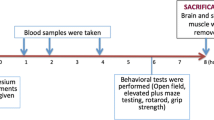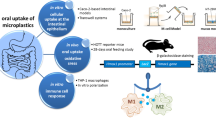Abstract
In fed guinea pigs, an oral dose of 6.4 g/kg of ethanol given as a 40% solution (v/v) produced a maximal blood alcohol level of 6.8±0.3 mg/ml, whereas in fed rats, blood alcohol levels after the same dose did not exceed 2.1±0.2 mg/ml. Maximal blood alcohol levels in fasted animals after an oral load of 4.8 g/kg of ethanol were 6.3±0.2 mg/ml in guinea pigs and 3.7±0.3 mg/ml for rats. However, i.v. injected ethanol (1 g/kg) was eliminated at the same rate in both species (275 mg per kg · h), and ADH activity of the liver related to body weight was by 20% greater in guinea pigs than in rats.
Therefore, absorption of ethanol occurs at a much slower rate in rats than in guinea pigs. This is possibly due to the fact that high ethanol concentrations strongly delay emptying of the rat stomach. Lowering the ethanol concentration accelerates absorption rate in the rat. However, even after gavage of a 10% solution peak levels of blood alcohol were still lower by 36% in rats than in guinea pigs.
In guinea pigs, increased serum activities of GOT, GPT, and GLDH occurred after an oral dose of 4.8 g/kg or 6.4 g/kg of ethanol, respectively. SGOT already increased after 1.6 g/kg of ethanol p.o. After 6.4 g/kg of ethanol given to rats serum transaminase levels increased only slightly, and GLDH activity not at all. Vacuolar degeneration was the morphological substrate of ethanol-induced liver damage in guinea pigs and rats. In guinea-pigs, it occurred already after 1.6 g/kg of ethanol, whereas in rats only after 6.4 g/kg.
In conclusion, the guinea pig seems to be better suited for research on alcohol toxicity than the rat.
Zusammenfassung
Die maximalen Blutalkoholkonzentrationen nach oraler Gabe von 6,4 g/kg Äthanol in Form einer 40%igen Lösung (v/v) betrugen bei nicht nüchternen Meerschweinchen 6,8±0,3 mg/ml, bei nicht nüchternen Ratten dagegen nur 2,1±0,2 mg/ml. An nüchternen Tieren führte eine orale Alkoholbelastung von 4,8 g/kg zu maximalen Blutalkoholspiegeln von 6,3±0,2 mg/ml bei den Meerschweinchen und 3,7±0,3 mg/ml bei den Ratten. Intravenös injizierter Alkohol (1 g/kg) wurde demgegenüber von beiden Species mit der gleichen Geschwindigkeit eliminiert (275 mg/kg · Std), und die auf das Körpergewicht bezogene ADH-Aktivität der Leber war bei den Meerschweinchen um 20% größer als bei den Ratten.
Die Resorption von Äthanol erfolgt somit bei Ratten erheblich langsamer als bei Meerschweinchen. Dies dürfte darauf beruhen, daß konzentrierte Alkohollösungen die Magenentleerung der Ratte stark verzögern. Niedriger konzentrierte Alkohollösungen werden von der Ratte schneller resorbiert; jedoch waren auch nach Gabe von 10%igem Alkohol die maximalen Blutalkoholspiegel bei Ratten noch um 36% niedriger als bei Meerschweinchen.
Bei den Meerschweinchen waren nach oraler Gabe von 4,8 bzw. 6,4 g/kg Äthanol die Serumaktivitäten der GOT, GPT und GLDH erhöht; ein Anstieg der SGOT trat schon nach 1,6 g/kg Äthanol auf. Demgegenüber kam es bei Ratten nach 6,4 g pro kg Äthanol p.o. nur zu geringfügigen Aktivitätserhöhungen der Serumtransaminasen, während die Serumaktivität der GLDH unverändert blieb. Vacuolige Degeneration war das morphologische Substrat der durch Äthanol bei Meerschweinchen und Ratten ausgelösten Leberschädigung. Während diese Veränderung bei Meerschweinchen bereits nach einer Äthanoldosis von 1,6 g/kg auftrat, wurde sie bei Ratten erst nach 6,4 g/kg beobachtet.
Schlußfolgerung: Das Meerschweinchen ist für Untersuchungen zur Toxicität von Äthanol besser geeignet als die Ratte.
Similar content being viewed by others
References
Altland, P. D., Highman, B., Parker, M., Dieter, M. P.: Serum enzyme, corticosterone and tissue changes in rats following a single oral dose of ethanol. Quart. J. Stud. Alcohol 31, 281–287 (1970)
Bode, Ch., Goebell, H., Stähler, M.: Änderungen der Alkoboldehydrogenase-Aktivität in der Rattenleber durch Eiweißmangel und Äthanol. Z. ges. exp. Med. 152, 111–124 (1970)
Bücher, Th., Redetzki, H.: Eine spezifische photometrische Bestimmung von Äthylalkohol auf fermentativem Wege. Klin. Wschr. 29, 615–616 (1951)
Carter, E. A., Isselbacher, K. J.: The metabolism of ethanol to carbon dioxide by stomach and small intestinal slices. Proc. Soc. exp. Biol. (N.Y.) 138, 817–819 (1971)
Eggstein, M., Kreutz, P. H.: Eine neue Bestimmung des Neutralfetts im Blutserum und Gewebe. Klin. Wschr. 44, 262 (1966)
Elbel, H., Schleyer, F.: Blutalkohol, 2nd ed. Stuttgart: Thieme 1956
Hartroft, W. S.: The experimental approach to alcoholic liver damage. In: Biological basis of alcoholism (Israel, Y., Mardones, J., Eds.), p. 103–131. New York-London-Sidney-Toronto: Wiley Interscience 1971
Le Breton, E., Nicloux, M., Schaeffer, G.: Coefficient d'éthyloxydation et métabolisme de base chez quelques espèces homéothermes. C. R. Acad. Sci. (Paris) 200, 1133–1135 (1935)
Maling, H. M., Highman, B., Hunter, J. M., Butler, W. M.: Blood alcohol levels, triglyceride fatty livers, and pathologic changes in rats after single large doses of alcohol. In: Biochemical factors in alcoholism (Maickel, R. P., Ed.), p. 185–199. Oxford: Pergamon 1967
Siegers, C.-P., Strubelt, O., Back, G.: Inhibition by caffeine of ethanol absorption in rats. Europ. J. Pharmacol. 20, 181–187 (1972)
Soehring, K.: Pharmakologie des Aethanols. In: Alkohol und Coffein (Lang, K., Ed.), p. 29–39. Darmstadt: Dietrich Steinkopff 1970
Strubelt, O., Siegers, C.-P., Breining, H.: Die akute hepatotoxische Wirkung unterschiedlich konzentrierter Alkohollösungen bei oraler und intraperitonealer Applikation. Arch. Toxikol. 29, 129–141 (1972)
Wallgren, H., Barry, H. III: Actions of alcohol, Vol. I. Amsterdam-London-New York: Elsevier 1970
v. Wartburg, J.-P., Aebi, H.: Stoffwechsel von Aethanol. In: Alkohol and Coffein (Lang, K., Ed.), p. 1–15. Darmstadt: Dietrich Steinkopff 1970
Wuermeling, H.-B.: Vortrag Tagg. dtsch. Ges. gerichtl. Med., Hamburg 1966; zit. nach Soehring
Author information
Authors and Affiliations
Rights and permissions
About this article
Cite this article
Strubelt, O., Siegers, C.P. & Breining, H. Comparative study of the absorption, elimination and acute hepatotoxic action of ethanol in guinea pigs and rats. Arch. Toxicol. 32, 83–95 (1974). https://doi.org/10.1007/BF00316229
Received:
Issue Date:
DOI: https://doi.org/10.1007/BF00316229
Key words
- Alcohol, Ethyl
- Absorption
- Elimination
- Alcohol Oxidoreductases
- Hepatitis, Toxic
- Transaminases
- Glutamate Dehydrogenase
- Guinea Pig
- Rat




